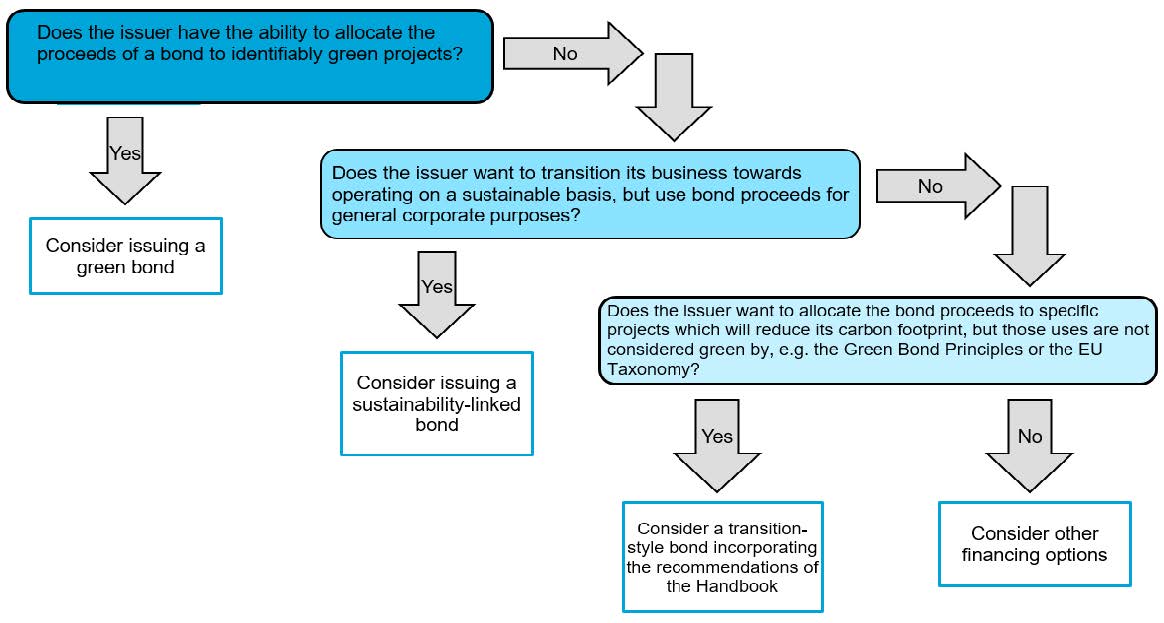
Climate Transition Finance Handbook bridges the sustainable finance gap for carbon-intensive issuers
6 min read
The International Capital Market Association ("ICMA") has published its much anticipated Climate Transition Finance Handbook1 (the "Handbook"). Unlike previous releases, the Handbook does not comprise a formal set of 'Transition Bond Principles', nor seek to create a distinct asset class of 'transition bonds', but rather seeks to give guidance to issuers on devising and evidencing their overarching sustainable transition strategies and the bonds they issue to achieve them. The Handbook can be used in conjunction with the existing sustainable finance principles.
2020: the year for transitioning issuers
2020 has been another evolutionary year for sustainable finance in spite of market volatility mainly brought about by the fall out of the COVID-19 pandemic. This year the sustainable bond market opened up to a new class of issuer – the climate transitioning issuer. These are issuers who are at a point further away from having a business model consistent with the Paris Agreement targets, some of whom cannot presently allocate large quantities of capital exclusively to projects which are identifiably green under the Green Bond Principles2 or the EU Taxonomy3. They require assistance to help them along a trajectory towards transitioning to Paris Agreement targets.
The Sustainability-Linked Bond Principles ("SLBPs")4 were the first to bring transitioning issuers into the fold, providing for a sustainable capital markets product that did not require a sizable pipeline of sustainable projects as the green use of proceeds model requires. The SLBPs do not require a green use of proceeds. Instead, the issuer demonstrates a measurably positive shift through pre-determined key performance indicators which track the sustainability of its business activities over a given time. This diversification has been further strengthened by the publication of the Handbook and accompanying Q&A document5 which give guidance on how transitioning issuers can most effectively demonstrate, disclose and credibly communicate their transition strategy to their investors and transparently raise finance to support that transition strategy.
What does the Handbook recommend?
The Handbook provides a set of recommendations that companies looking to transition their business model to a sustainable basis should follow to aid their strategy, give it credibility and to ensure it is sufficiently ambitious to affect a real transition to a more sustainable business. The Handbook offers a timely tool given the pressure from grass roots organisations, investors, regulators and governments for even the most polluting industries to transition to low carbon emissions. There is considerable momentum behind this movement and a growing number of companies committing to net-zero emissions at various times in the coming decades. The substantive content of the Handbook is summarised below:
| Climate Transition Finance Guidelines – a summary | |
| 1: Issuer's climate transition strategy and governance | The financing purpose should relate to the issuer's climate change strategy, which should be clearly communicated. A 'transition' label applied to debt should indicate the implementation of a strategy to transform the issuer's business model towards alignment with the goals of the Paris Agreement. This strategy may be disclosed under standard frameworks such as the Taskforce on Climate-related Financial Disclosures ("TCFD"), and should clearly and realistically set out the issuer's trajectory towards Paris Agreement alignment. |
| 2: Business model environmental materiality | The planned climate transition trajectory should be relevant to the environmentally-material parts of the issuer's core business model, accounting for potential future scenarios which may impact on current determinations of materiality. This will be especially the case for carbon-intensive companies, and those with significant quantities of assets which could become 'stranded' in future. This will facilitate the transition financing having maximum positive impact, ensuring the transition aspect of the corporate strategy is not incidental to the issuer's core business and reduce the risk of 'greenwashing'. |
| 3: Climate transition strategy to have science-based trajectories | Issuer's climate strategy should reference science-based targets and transition pathways. These are increasingly well understood in the scientific community. Having a decarbonisation trajectory which is consistent with science-based pathways will make it more credible. In particular, the transition trajectory should: (a) be quantitatively measurable (based on a consistent measurement methodology); (b)align with science-based trajectories where they exist; (c) be publicly disclosed, potentially via a recognised disclosure framework (e.g. CDP, Science-Based Targets Initiative, TCFD, etc.), and; (d) be independently verified. |
| 4: Implementation transparency | To the extent practicable, transparency should be provided on the investment programme underlying the transition strategy. This should include details of where any such operating expenditure is deemed 'non-business as usual', as well as other relevant information indicating how the programme supports the implementation of the transition strategy. |
Fig 1: Climate Finance Decision Tree
Why transition?
Roughly 100 companies are said to account for over 70% of greenhouse gas emissions globally, so these companies could have the greatest positive impact in terms of global decarbonisation if they transitioned to a more sustainable business model. They should be encouraged and enabled to transition to a sustainable path. Without transitioning carbon intensive industries, the world will likely fail to reach the Paris Agreement targets. Equally, there is a growing pressure from financial institutions for companies to shift away from the most polluting activities. Many banks are already refusing to provide financing for certain carbon-intensive activities, and have set out their own timelines for when various other highly polluting activities will no longer be financed, in line with their own goals towards Paris Agreement alignment. Therefore, if the most carbon intensive companies do not adapt their business models, they could see the cost of capital increase and/or become unavailable. Companies are also facing pressure from national regulators. Thousands of companies in the EU will soon have to disclose what proportion of their business activities are aligned with the EU Taxonomy, and the UK is considering requiring companies to disclose against the TCFD reporting framework. As the deadline for hitting net zero global greenhouse gas emissions creeps closer, regulatory regimes are expected to become increasingly stringent.
Concluding thoughts
The Handbook is a vital tool to enable global adherence to the Paris Agreement targets. It paves the way for the most carbon-intensive issuers to enter the sustainable finance market and devise meaningful roadmaps to decarbonisation. This addresses the erstwhile emissions elephant in the room: without incrementally adapting the highest polluting companies to a low carbon economy, bringing about a low-carbon economy cannot feasibly be achieved at all.
1 https://www.icmagroup.org/assets/documents/Regulatory/Green-Bonds/Climate-Transition-Finance-Handbook-December-2020-091220.pdf
2 https://www.icmagroup.org/assets/documents/Regulatory/Green-Bonds/Green-Bonds-Principles-June-2018-270520.pdf
3 https://ec.europa.eu/info/business-economy-euro/banking-and-finance/sustainable-finance/eu-taxonomy-sustainable-activities_en
4 https://www.icmagroup.org/assets/documents/Regulatory/Green-Bonds/June-2020/Sustainability-Linked-Bond-Principles-June-2020-171120.pdf
5 https://www.icmagroup.org/assets/documents/Regulatory/Green-Bonds/CTF-Handbook-QA-09122020.pdf
This publication is provided for your convenience and does not constitute legal advice. This publication is protected by copyright.
© 2020 White & Case LLP

